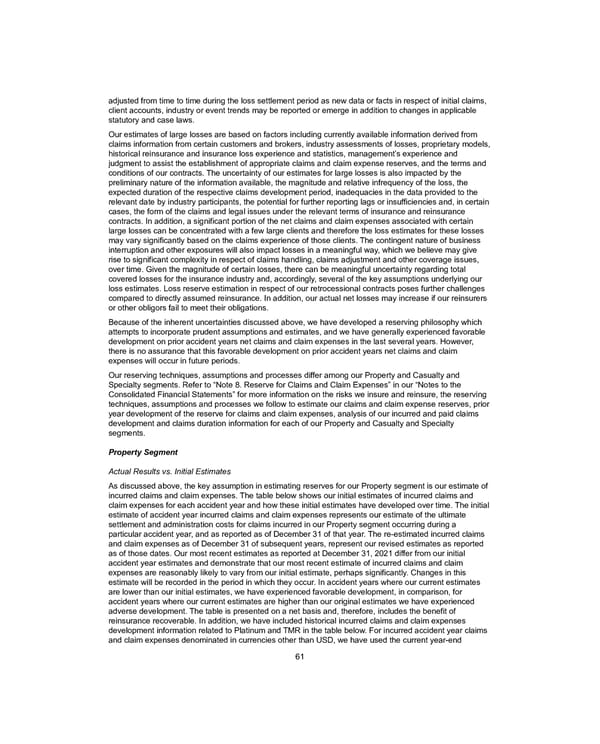adjusted from time to time during the loss settlement period as new data or facts in respect of initial claims, client accounts, industry or event trends may be reported or emerge in addition to changes in applicable statutory and case laws. Our estimates of large losses are based on factors including currently available information derived from claims information from certain customers and brokers, industry assessments of losses, proprietary models, historical reinsurance and insurance loss experience and statistics, management’s experience and judgment to assist the establishment of appropriate claims and claim expense reserves, and the terms and conditions of our contracts. T he uncertainty of our estimates for large losses is also impacted by the preliminary nature of the information available, the magnitude and relative infrequency of the loss, the expected duration of the respective claims development period, inadequacies in the data provided to the relevant date by industry participants, the potential for further reporting lags or insufficiencies and, in certain cases, the form of the claims and legal issues under the relevant terms of insurance and reinsurance contracts. In addition, a significant portion of the net claims and claim expenses associated with certain large losses can be concentrated with a few large clients and therefore the loss estimates for these losses may vary significantly based on the claims experience of those clients. The contingent nature of business interruption and other exposures will also impact losses in a meaningful way, which we believe may give rise to significant complexity in respect of claims handling, claims adjustment and other coverage issues, over time. Given the magnitude of certain losses, there can be meaningful uncertainty regarding total covered losses for the insurance industry and, accordingly, several of the key assumptions underlying our loss estimates. Loss reserve estimation in respect of our retrocessional contracts poses further challenges compared to directly assumed reinsurance. In addition, our actual net losses may increase if our reinsurers or other obligors fail to meet their obligations. Because of the inherent uncertainties discussed above, we have developed a reserving philosophy which attempts to incorporate prudent assumptions and estimates, and we have generally experienced favorable development on prior accident years net claims and claim expenses in the last several years. However, there is no assurance that this favorable development on prior accident years net claims and claim expenses will occur in future periods. Our reserving techniques, assumptions and processes differ among our Property and Casualty and Specialty segments. Refer to “Note 8. Reserve for Claims and Claim Expenses” in our “Notes to the Consolidated Financial Statements” for more information on the risks we insure and reinsure, the reserving techniques, assumptions and processes we follow to estimate our claims and claim expense reserves, prior year development of the reserve for claims and claim expenses, analysis of our incurred and paid claims development and claims duration information for each of our Property and Casualty and Specialty segments. Property Segment Actual Results vs. Initial Estimates As discussed above, the key assumption in estimating reserves for our Property segment is our estimate of incurred claims and claim expenses. The table below shows our initial estimates of incurred claims and claim expenses for each accident year and how these initial estimates have developed over time. The initial estimate of accident year incurred claims and claim expenses represents our estimate of the ultimate settlement and administration costs for claims incurred in our Property segment occurring during a particular accident year, and as reported as of December 31 of that year. The re-estimated incurred claims and claim expenses as of December 31 of subsequent years, represent our revised estimates as reported as of those dates. Our most recent estimates as reported at December 31, 2021 differ from our initial accident year estimates and demonstrate that our most recent estimate of incurred claims and claim expenses are reasonably likely to vary from our initial estimate, perhaps significantly. Changes in this estimate will be recorded in the period in which they occur. In accident years where our current estimates are lower than our initial estimates, we have experienced favorable development, in comparison, for accident years where our current estimates are higher than our original estimates we have experienced adverse development. The table is presented on a net basis and, therefore, includes the benefit of reinsurance recoverable. In addition, we have included historical incurred claims and claim expenses development information related to Platinum and TMR in the table below. For incurred accident year claims and claim expenses denominated in currencies other than USD, we have used the current year-end 61
 2021 Annual Report Page 76 Page 78
2021 Annual Report Page 76 Page 78